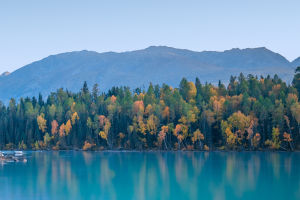Grand Teton National Park is a stunning wilderness area located in the northwestern region of Wyoming, USA. Established in 1929, the park covers more than 310,000 acres of pristine mountains, lakes, and rivers, and is home to an abundance of wildlife, including grizzly bears, elk, and bald eagles.
At the center of the park is the Teton Range, a majestic mountain range that rises more than 7,000 feet above the valley floor. The highest peak in the range is Grand Teton, at more than 13,700 feet. Due to its breathtaking scenery and challenging terrain, the range is a popular destination for hikers, climbers, and photographers.
The park also includes several beautiful lakes, including Lake Jackson, Lake Jenny, and Lake Lee, which offer opportunities for boating, fishing, and other water activities. The Snake River runs through the park, offering additional opportunities for fishing and scenic rafting trips.
In addition to its natural beauty, Grand Teton National Park is also rich in cultural history. The park features several historic homesteads and ranches, as well as associated sites of Native American tribes that have called the area home for centuries.
Overall, Grand Teton National Park is a must-see for nature lovers and outdoor enthusiasts, offering a unique combination of awe-inspiring natural beauty, abundant wildlife, and rich cultural heritage.
The viewing season in Grand Teton National Park varies depending on what interests you. Here are some general guidelines for the best time to view different aspects of the park:
Wildlife: The best times to see wildlife in Grand Teton National Park are summer and fall (June through October). Animals are most active and more numerous during this period. Especially during the rutting season of the year, September and October are excellent times to see elk.
Wildflowers: Wildflower season in Grand Teton National Park typically begins in May and continues through summer (June through August). Wildflower season varies with snowmelt and precipitation but usually occurs in mid-July.
Fall Foliage: Fall foliage season in Grand Teton National Park typically occurs in September and October, when aspens and poplars turn yellow and gold. The timing of peak fall foliage can vary depending on weather conditions and altitude.
Scenery: Grand Teton National Park's scenery is breathtaking year-round, but summer (June-August), with its milder weather and longer hours of sunshine, is generally considered the best time to visit.
Overall, Grand Teton National Park is a beautiful destination worth visiting year-round, with each season offering its own unique viewing opportunities.


